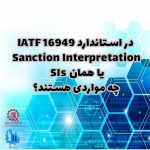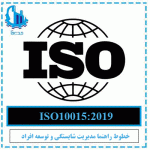Contact our experts at Modirfa to get free advice on planning and production management.
02188764867 – 02188761795
ISO 31000 Risk Management
In the complex and competitive world of business, risk management has become a key component for the success and sustainability of any organization. The International Organization for Standardization (ISO) provides a framework for effective and efficient risk management in all types of organizations. Here we will explore what the ISO 31000 standard is, what it is for, and how it can benefit your company.
What is the ISO 31000 standard?
The ISO 31000 standard is a set of international guidelines and principles that provide a systematic and structured approach to identify, assess, treat and monitor risks in any organization. This standard was first published in 2009 and was last updated in 2018. Its primary purpose is to help organizations protect their assets, achieve their goals, and improve decision-making.
Structure and components of ISO 31000
The ISO 31000 standard is based on three main components: Risk management principles, framework and process. These components are interconnected and reinforce each other to provide a coherent and effective approach to risk management.
Principles
This standard establishes 8 principles that any organization seeking to implement a risk management system based on ISO 31000 must follow. These principles are:
Integration
Risk management must be integrated at all levels of the organization and in all processes.
Structured
Risk management must have a structured approach in the governance of the organization.
Personalization
Risk management should be tailored to the specific needs and characteristics of each organization.
Inclusion
All relevant stakeholders should participate in the risk management process.
Dynamism
Risk management must be proactive and able to adapt to changes in the internal and external environment.
Continual improvement
The organization should constantly look for opportunities to improve its risk management approach.
Evidence-based
Decision making in risk management should be based on accurate and up-to-date information.
Human and cultural factors
Human behavior and culture affect risk management.
Risk management framework
ISO 31000 provides a framework aimed at helping organizations to integrate risk management into all their core activities and functions. To achieve this goal, the support and commitment of stakeholders, especially top management, is essential. The development of the framework includes the integration, design, implementation, evaluation and continuous improvement of risk management throughout the organization.
Benefits of implementing and receiving the ISO 31000 standard
Adopting the ISO 31000 standard can provide a range of benefits to organizations, including:
Improved decision making: ISO 31000-based risk management helps organizations make informed, data-driven decisions that lead to more effective and predictable outcomes.
Protection of assets: Organizations can protect their assets and resources against possible losses or damages by proactively and systematically managing risks.
Regulatory compliance: Adoption of ISO 31000 can facilitate compliance with applicable legal and regulatory requirements by providing a structured and coherent approach to risk management.
Competition and growth: Organizations that effectively manage their risks can seize opportunities and face challenges more effectively, enabling them to be more competitive and sustainable in the market.
Search
Categories
- automobile industry
- change management
- Communication with the customer
- coronavirus
- data science
- Foodstuffs
- Industry 4
- Key indicators
- Laboratory
- Medical equipment industry
- News
- Organization excellence and design
- Process management
- Product certification
- Project Management
- Quality management
- Radio Modirfa
- risk management
- Safety and health
- Standard text and translation
- Strategy
- The field of strategy and excellence
- Uncategorized
The Latest Posts

SIs published interpretations of the IATF16949 standard

Health care management: Providing quality to the health industry

Translation of ISO10015:2019 standard text
Subscribe to the newsletter
Get all latest content delivered to your email a few times a month.

